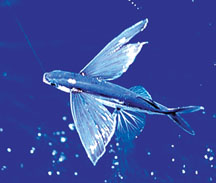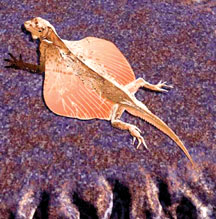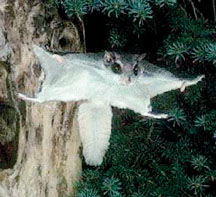
Flying without wings
You may be familiar with birds that fly, but squirrels, lizards,
frogs, snakes or for that matter fish? Perhaps not. Some of you may
wonder whether such 'flying' animals could only be found in story books
or movies.
No, they do exist in the real world, if only you take time to learn
about the numerous creatures that exist in the animal kingdom. However,
keep in mind that these animals, which are known as the flying
squirrels, flying snakes, flying fish and so on, do not actually fly
like our feathered friends - the birds, because they have no wings.
Neither do they use wind currents to soar up in the skies like birds do,
but they do move freely in the air for quite long distances, to get from
one point to another.
This unusual mode of transport of moving through the air without
wings is called gliding. So, why are these animals called flying
squirrels or flying fish, you may question. Well, because even though
they have no powered flight like the birds, their gliding methods look
so close to flying. And, naturally they have come to be classed as a
group of animals that could 'fly'.
Now, let's look at how exactly each of these animals manage to fly
even though none of them have wings.
Fish that fly
There are over 50 species of flying fishes belonging to the family
Exocoetidae. They are mostly marine fishes of small to medium size, with
the largest among them reaching a length of 45 cm. Most species measure
less than 30 cm in length.

Flying fish can easily be identified by their huge flying fins and
lopsided tails. Young fish look quite different from adults. They have
variegated colour patterns (diversity by patches of different colours),
and a pair of flap-like whiskers that extend downward from the end of
the lower jaw and are sometimes longer than the fish itself. These
whiskers disappear as the fish grows.
These flying fish are capable of jumping out of the water and gliding
over considerable distances. There are two-winged flying fish with
exceptionally large pectoral fins, and four-winged flying fish, which
also have enlarged pelvic fins used for gliding.

In general, their tails are deeply forked, and the lower lobe of the
tail is much longer and larger than the upper lobe. When these fish want
to escape from hungry predators such as starfish, they take to the air.
They leap out of the water, up to about 2m (6 feet) and then glide along
with outstretched fins. In preparation for flight, they quickly swim
towards the water's surface, leap out of the water and spread their
chest fins like wings, keeping them airborne for up to 100 m (325 feet).
Studies have revealed that flying fish hold their enlarged pectoral
fins relatively steady and glide through the air, like the lizards,
squirrels and snakes that fly. Birds vibrate their wings during flight,
but these flying fish don't.
Even lizards take to the air

Like the squirrels, these small lizards 'fly' or glide hundreds of
feet from tree to tree. They do so using the extra skin flaps they have
between their front and hind limbs. They have long ribs, some of which
fold back against the sides of their bodies, that they extend when
leaping from tree to tree.
When these lizards spread their ribs, opening umbrella-like fans of
skin, and leap from a tree and glide, sometimes up to about 20 m (60
feet), they truly look as if they are flying.
Some species of lizards are considered to be champion gliders.
Squirrels can also fly
You may be aware that squirrels are mammals and belong to the order
of 'gnawing mammals' (Rodentia). The name 'squirrel' comes from the
Middle English word 'Squirrel', which in turn comes from the Greek word
'Skiouros'. The flying squirrels are scientifically known as
Petauristinae or Pteromyinae. There are about 36 species in this
sub-family of squirrels and the largest among them is considered to be
the Woolly Flying Squirrel.

Found mostly in tropical forests in different locations (according to
the species), such as the Ivory Coast, Liberia, Guinea, and North
America, these squirrels generally have dense, bristly coats. The
squirrel identified as Pel's Flying Squirrel is said to be black on top
with a white underside. Its body is around 18 inches long, with an
additional 14 inch long tail which it uses effectively when flying. It
weighs just under two pounds.
There are two sub-species of flying squirrels which are native to
North America, which are grouped as the Northern and Southern flying
squirrels.
What helps them fly?
A fold of skin from the front limbs which is attached to the hind
legs, and the base of the tail, near where it joins the body helps these
rodents to fly.
These loose folds of skin between the front and hind legs on either
side stretch and act as 'wings' when they extend their limbs. Once they
have launched themselves into the air, they have no way of propelling
themselves forward, like birds do, by flapping their wings. They simply
glide, even though they lose height while doing so. The squirrels can
steer themselves or control direction by tensing and turning their legs
and body, and also flapping their tail.

The tail acts as a stabiliser in flight, very much like the tail of a
kite. They can turn easily at right angles while gliding as far as 150
feet or more from a height of 60 feet! As they approach landing, the
squirrels flip the tail up and hold their body back to slow the glide
down. This gives them ample time to position their feet for grasping the
tree trunks. As the squirrels have sharp, long claws, they can easily
grasp the tree trunks. They usually land face up.
In the wilds, they live only for about five years, but in captivity
they often live up to 10 and 15 years.
Fact file
* They eat berries, blossoms, acorns, seeds and fruit which are all
found on trees, where they usually take refuge, and also moths, insects,
birdlings and eggs.
* They glide from tree to tree, covering distances up to 165 feet.
* Their enemies include snakes, racoons, nocturnal owls, coyote and
the domestic house cat.
* They are sociable animals with strong maternal instincts.
* Some species are known to make affectionate and playful pets.
* Flying squirrels are active all year round.
More on flying animals next week. |


